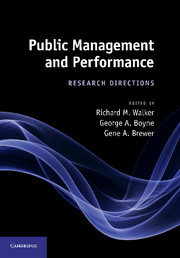Book contents
- Frontmatter
- Contents
- List of figures
- List of tables
- Notes on contributors
- 1 Introduction
- 2 Extending goal ambiguity research in government: from organizational goal ambiguity to programme goal ambiguity
- 3 Budgets and financial management
- 4 Organizational structure and public service performance
- 5 Red tape: the bane of public organizations?
- 6 Managerial networking, managing the environment, and programme performance: a summary of findings and an agenda
- 7 Public service motivation and performance
- 8 Organizational diversity and public service performance
- 9 Performance management: does it work?
- 10 Strategy: which strategic stances matter?
- 11 Methods
- 12 Conclusion: enriching the field
- Index
- References
10 - Strategy: which strategic stances matter?
Published online by Cambridge University Press: 05 July 2014
- Frontmatter
- Contents
- List of figures
- List of tables
- Notes on contributors
- 1 Introduction
- 2 Extending goal ambiguity research in government: from organizational goal ambiguity to programme goal ambiguity
- 3 Budgets and financial management
- 4 Organizational structure and public service performance
- 5 Red tape: the bane of public organizations?
- 6 Managerial networking, managing the environment, and programme performance: a summary of findings and an agenda
- 7 Public service motivation and performance
- 8 Organizational diversity and public service performance
- 9 Performance management: does it work?
- 10 Strategy: which strategic stances matter?
- 11 Methods
- 12 Conclusion: enriching the field
- Index
- References
Summary
Introduction
Strategy, or strategic management, is concerned with the means and ends of service delivery – organizational behaviour, organizational action and performance. In public agencies strategic management focuses on mission and organizational purpose, sometimes referred to as the creation of public value, sources of support and legitimacy together with operational matters to ensure that purposes are achieved (Moore 1995). Put another way, it is about ‘maximiz[ing] value, given a number of choice constraints’ (Lane and Wallis 2009: 105). Strategy has been described as managing outwards to stakeholders and citizens, upwards to political authority and downwards or inwards to the ‘organization’s current performance’ (Moore 1995: 73). Haass’s (1999) analogy of a compass similarly notes the holistic nature of strategic management: a public service manager is at the centre and manages north up the hierarchy to superior officers and politicians, south to employees, east to other colleagues in the organization and west to those outside the organization who may affect the work of the manager and public agency. Common to these three brief definitions of strategic management are: organizational process and practices that focus on weighing up and balancing opportunities and constraints from the environment with internal capabilities, with the aim of enhancing public value and to achieve higher levels of organizational performance.
- Type
- Chapter
- Information
- Public Management and PerformanceResearch Directions, pp. 227 - 252Publisher: Cambridge University PressPrint publication year: 2010



